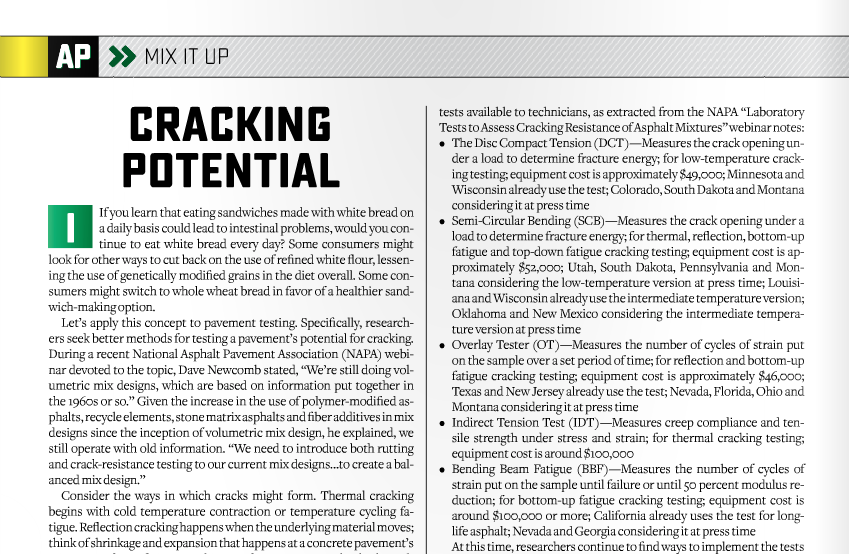Add Volume in Favor of Better Crack Testing
BY Sandy Lender

If you learn that eating sandwiches made with white bread on a daily basis could lead to intestinal problems, would you continue to eat white bread every day? Some consumers might look for other ways to cut back on the use of refined white flour, lessening the use of genetically modified grains in the diet overall. Some consumers might switch to whole wheat bread in favor of a healthier sandwich-making option.
Let’s apply this concept to pavement testing. Specifically, researchers seek better methods for testing a pavement’s potential for cracking. During a recent National Asphalt Pavement Association (NAPA) webinar devoted to the topic, Dave Newcomb stated, “We’re still doing volumetric mix designs, which are based on information put together in the 1960s or so.” Given the increase in the use of polymer-modified asphalts, recycle elements, stone matrix asphalts and fiber additives in mix designs since the inception of volumetric mix design, he explained, we still operate with old information. “We need to introduce both rutting and crack-resistance testing to our current mix designs…to create a balanced mix design.”
Consider the ways in which cracks might form. Thermal cracking begins with cold temperature contraction or temperature cycling fatigue. Reflection cracking happens when the underlying material moves; think of shrinkage and expansion that happens at a concrete pavement’s joints. Top-down fatigue cracking tends to propagate slowly through aged, thick, stiff pavements. Bottom-up fatigue cracking takes place when repeated loads bend a pavement—usually a thin one—at its base, propagating the cracks upward.
Each of these phenomena has its own trigger. Each has its own set of conditions making it possible—causing its formation and acceleration. For that reason, each of these phenomena should have its own method of determination. From the discussions I’ve covered at national conferences and webinars, I posit each cracking method deserves its own testing method to determine its probability. If you take a quick look around the testing segment of our industry, I’m not the only one.

Table 1
NCHRP Project 9-57 was set in motion to identify testing methods for the four types of pavement cracking listed above. As of November 2015, the interim report had identified four working tests for low-temperature cracking, three for reflection cracking, five for bottom-up fatigue cracking, and four for top-down fatigue cracking, and researchers had prepared videos showing proper execution of the test methods (See Cracking Tests Table). Let’s take a quick “layman’s terms” look at the tests available to technicians, as extracted from the NAPA “Laboratory Tests to Assess Cracking Resistance of Asphalt Mixtures” webinar notes:
- The Disc Compact Tension (DCT)—Measures the crack opening under a load to determine fracture energy; for low-temperature cracking testing; equipment cost is approximately $49,000; Minnesota and Wisconsin already use the test; Colorado, South Dakota and Montana considering it at press time
- Semi-Circular Bending (SCB)—Measures the crack opening under a load to determine fracture energy; for thermal, reflection, bottom-up fatigue and top-down fatigue cracking testing; equipment cost is approximately $52,000; Utah, South Dakota, Pennsylvania and Montana considering the low-temperature version at press time; Louisiana and Wisconsin already use the intermediate temperature version; Oklahoma and New Mexico considering the intermediate temperature version at press time
- Overlay Tester (OT)—Measures the number of cycles of strain put on the sample over a set period of time; for reflection and bottom-up fatigue cracking testing; equipment cost is approximately $46,000; Texas and New Jersey already use the test; Nevada, Florida, Ohio and Montana considering it at press time
- Indirect Tension Test (IDT)—Measures creep compliance and tensile strength under stress and strain; for thermal cracking testing; equipment cost is around $100,000
- Bending Beam Fatigue (BBF)—Measures the number of cycles of strain put on the sample until failure or until 50% modulus reduction; for bottom-up fatigue cracking testing; equipment cost is around $100,000 or more; California already uses the test for long-life asphalt; Nevada and Georgia considering it at press time
At this time, researchers continue to find ways to implement the tests in the field. The hope is to one day have quality assurance performance testing that will allow us to build balanced mix designs that solve all potential pavement problems, including the various types of cracking in the various climates of North America. A lofty goal, to be sure.
When we look back on roads of the past, we have examples of perpetual pavements that exhibit few cracks, few structural problems. This may lead contractors, producers and mix design techs alike to look at the volumetric mix design process from the 1960s and ask, “why not use what we’ve always used?” As Newcomb pointed out in his talk, our additives and asphalts have changed.
Just as the consumers choosing between old-school white-flour breads and healthful whole wheat breads, members of the asphalt industry have existing information that no longer fits today’s environment. Why would we elect to use old data and old methods on new mixes with new ingredients to construct new pavements for new traffic loads? We wouldn’t. By changing our testing protocol, we adjust to new ways to build for tomorrow’s perpetual pavements.
